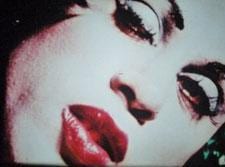Watching the late José Rodriguez Soltero’s 16mm films rekindled my love-hate relationship with avant-garde cinema. Long unseen, Jerovi from 1965 and Lupe from 1966 now seem to fit perfectly in the canon of ’60s American film culture, finding their space in the constellation whose other, brighter (canonized overkill) stars include the likes of Andy Warhol, Jack Smith, Kenneth Anger and (because I love to invoke her any chance I get) Maya Deren. Toronto’s Alucine festival (continuing till Sat, Nov 28) screens both Soltero rarities.
The 50-minute Lupe is ostensibly (and very loosely) based on the career of Lupe Velez, the Mexican actress perhaps best known in this day and age (thanks to Anger’s tale about her in Hollywood Babylon) as the woman who, despite attempting a graceful suicide, wound up drowning in her toilet — at least according to rumour. It’s raw, low-to-no budget filmmaking starring Mario Montez (who appeared in Smith’s Flaming Creatures and was a Warhol superstar). There’s lots of bad lighting, extreme blurry closeup work and a general lack of continuity along with all the requisite experimental camera movements and acknowledgment of the materiality of the cinematic form.
Jerovi, on the other hand, is a silent, 12-minute take on the Narcissus myth that involves a young man having a wank in Central Park, then rushing about in a gorgeous brocade cloak.
After the screening, I sorted through my various thoughts about what I’d just experienced — the vague menace of Deren crossed with the rapid-fire dreaminess of Anger; the devil-may-care raucous-ness of Smith with the meanness of Warhol — and decided that what really marks these films is none of these things: It’s their playfulness.
For example there’s something that approaches childlike play-acting in Mario Montez’s performance as Lupe, which involves a great deal of severe drag make-up, tatty glamour and some dramatic mugging. This is real, proper camp — not the bitchy queenery that goes by that name today — but a real, heartfelt sendup of a heroine. (Let’s not forget that Montez named himself after another Latin screen siren.) The film begins with Lupe on the telephone, with her mad red hair and mad red housecoat, after which she excitedly repeats, “I’m going to be a movie star again!” From here, it’s up, up, up, and then down, as Lupe’s final act is to turn on the gas and lie down forever.
Also amazingly striking is the intensity of colour saturation in the film, as though Soltero couldn’t get enough lipstick red. For me the most satisfying element of all is the makeshift sets. The best example is a sequence in which Lupe performs some form of veil dance in front of a filthy blanket pinned to a filthy wall in a filthy apartment. Imagination is the thing!
Jerovi is a very different film, restrained and poetic. Again Soltero indulges in colour saturation but here, rather than fire-engine red, we have the intensity of a verdant park in which a young man pleasures himself. In a near-comic sequence at the end he appears to be running sometimes toward, sometimes away from himself, until he comes to rest in the lush vegetation near a pool.
Both films are well worth a look, whether you are a cinephile with that incessant hunger to plug the gaps in your viewing knowledge, a freak for Latin-inflected Warhol-soaked New York in the ’60s or just a pop-culture junkie. You’ll find yourself fondly remembering playing dress-up and let’s pretend — assuming, of course, that you were that sort of child.
Jerovi and Lupe screen at 7:30pm and 9:30pm on Fri, Nov 20 at Cinecycle (129 Spadina Ave); admission is $8. There are lots of other queer offerings at Alucine, like the Brazilian doc on the burial of a trans woman, The Shoes of Aristeau, 7pm, Nov 23; and local docs Our Faces, Our Stories by Samuel Lopez and My First Time by Alex Flores, 7pm, Nov 26. Most screenings at Lennox Gallery (12 Ossington Ave); call (416) 971-4273 or go to Alucinefestival.com.

 Why you can trust Xtra
Why you can trust Xtra


